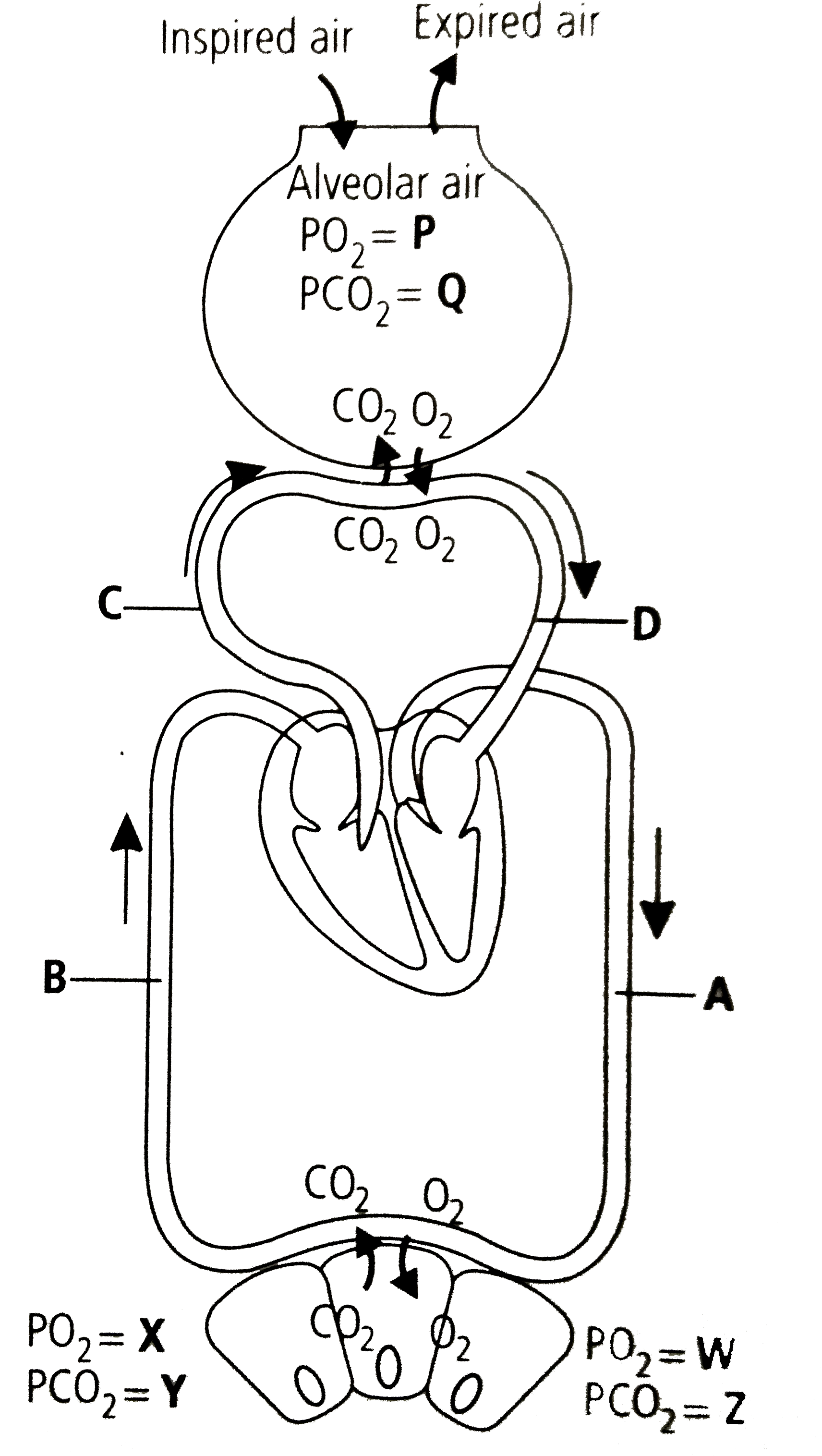I. The in alveolar air is about ….A…. Mm Hg and in arterial capillaries is …..B…… mm Hg. Therefore, oxygen from alveoli diffuses into blood capillaries.
II. in blood reaching alveolar capillaries is …..C…. Mm Hg and in alveolar air is .....D..... mm Hg. thus, leaves capillaries and reaches alveoli.
Identify A,B,C and D in the above two statements .
104, 40, 45, 40
40 , 104, 40, 45
40, 45, 104, 40
45, 104, 45, 40
The correct Answer is:A
Step by step video, text & image solution for I. The pO_(2) in alveolar air is about ….A…. Mm Hg and in arterial capillaries is …..B…… mm Hg. Therefore, oxygen from alveoli diffuses into blood capillaries. II. pCO_(2) in blood reaching alveolar capillaries is …..C…. Mm Hg and in alveolar air is .....D..... mm Hg. thus, CO_(2) leaves capillaries and reaches alveoli. Identify A,B,C and D in the above two statements . by Biology experts to help you in doubts & scoring excellent marks in Class 12 exams.
Updated on:21/07/2023Topper's Solved these Questions
- BREATHING AND EXCHANGE OF GASES BOOK - ARIHANT NEETCHAPTER - BREATHING AND EXCHANGE OF GASES EXERCISE - Chapter exercises B (Medical entrances special format questions )
21 Videos
- BREATHING AND EXCHANGE OF GASES BOOK - ARIHANT NEETCHAPTER - BREATHING AND EXCHANGE OF GASES EXERCISE - Chapter exercise C (Medical entrances gallery )
54 Videos
- BREATHING AND EXCHANGE OF GASES BOOK - ARIHANT NEETCHAPTER - BREATHING AND EXCHANGE OF GASES EXERCISE - Check point 24.3
20 Videos
- BODY FLUID AND CIRCULATIONBOOK - ARIHANT NEETCHAPTER - BODY FLUID AND CIRCULATIONEXERCISE - MEDICAL ENTRANCES GALLERY COLLECTION OF QUESTIONS ASKED IN NEET AND VARIOUS MEDICAL ENTRANCE EXAMS
72 Videos
- CELL CYCLE AND CELL DIVISIONBOOK - ARIHANT NEETCHAPTER - CELL CYCLE AND CELL DIVISIONEXERCISE - Chapter Exercises (C) Medical entrances gallery (collection of questions asked in NEET & Various medical entrance exams)
63 Videos
Similar Questions
The partial pressure (in mm Hg) of oxygen (O2) and carbon dioxide (CO2) at alveoli (the site of diffusion) are:
View SolutionThe diffusion membrane is made up of:
(A) Thick columnar epithelium of alveoli
(B) Endothelium of alveolar capillaries
(C) Basement substances in between capillaries and alveoli
View Solution
Knowledge Check
pCO2 of deoxygenated blood of a person is 48 mm of Hg. in this condition ,
APerson experience deep breathing and sho breathing rateBPerson experience no change in breathing pattemCHis O2 dissociation curve remains shifts towards leftDHis O2 dissociation curve remains shifed towards rightWhich of the following statement(s) is (are) true about respiration?
(i) During inhalation, ribs move inward and diaphragm is raised
(ii) In the alveoli, exchange of gases takes place i.e., oxygen from alveolar air diffuses into blood and carbon dioxide from blood into alveolar air
(iii) Haemoglobin has greater affinity for carbon dioxide than oxygen
(iv) Alveoli increase surface area for exchange of gasesA(i) and (iv)B(ii) and (iii)C(i) and (iii)D(ii) and (iv)The blood pressure inside capillaries connected to the arterioles and venules is 32 mm Hg and 7mm Hg respectively. What will be the pressure of interstitial fluid?
A22 mm HgB0 mm HgC7 mm HgD32 mm Hg
The venous blood in the lungs has a PCO2 of 46 mm Hg. Should the alveoalr PCO2 exceed or be less than 46 mm. Hg to result in diffusion of CO2 from the blood in the alveolus ?
View Solution
Durning strenuous exercise, the muscle interstitial fluid PO2 falls to 20 mm Hg. The oxygen delivered by blood that passes through the exercising muscle tissus will be
View SolutionAir contains 79%N2 and 21%O2 by volume. If the barometric pressure is 750mmHg. The partial pressure of oxygen is
View SolutionRead the following statement .
a) High H+ concentration and higher temperature are favourable for dissociation of oxygen from oxyhaemoglobin.
b) Partial pressure of oxygen in alveoli is higher than in tissue .
c) The maximum volume of air a person can breather in after a forced expiration is vital capacity.
d) In alveoli PCO2 low and PO2 high are for dissociation of CO2 from carbamino haemoglobin .
How many of the above statement are true ?
View SolutionAir enters in the lungs in a tiny cavity called alveoli. Oxygen diffuses into our blood from alveoli. The average radius of alveoli is 0.005 cm and air inside it contains 21% O2 and 79% N2. Assuming that the pressure in the aveoli is 1 atm at body temperature of 37∘C.
Volume of single alveoli is :
View Solution
